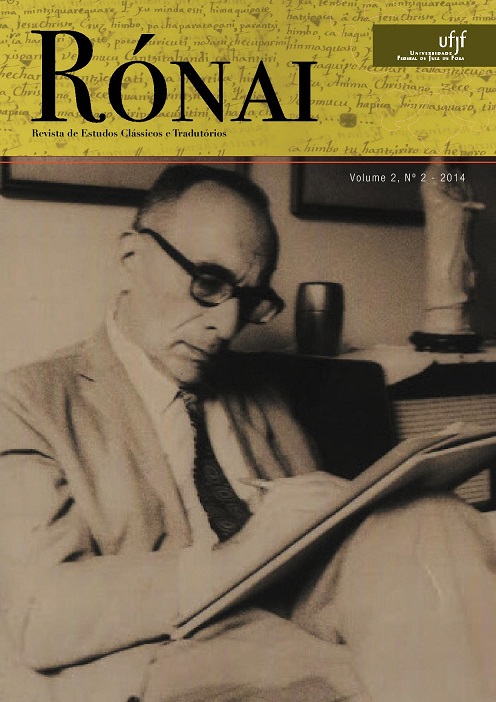Há vida além da morte no Coliseu?
Is there life after death in the Coliseum?
Palabras clave:
Poder, violência, espetáculo, poesiaResumen
Um espetáculo no Coliseu é argumento bastante em favor da idéia de que a realidade supera a ficção. O sangue vencido na arena, mais do que horror e violência, representa a consagração do poder imperial, que submete a selvageria, executa o traidor, supera aquele que ousa afrontar a sua superioridade romana. A execução sob o patrocínio do Estado não pretende figurar o teatro da comiseração, mas se fazer afirmação do direito de morte e vida. Será apresentado o poeta Marcial em seus versos de celebração do “Caesareo Amphitheatro”. O Objetivo é buscar entender que relações podem ser estabelecidas entre os valores intrínsecos da poesia e os projetos políticos implícitos na edificação daquele espaço celebrado.
Abstract
A show at the Coliseum is argument enough in favor of the idea that reality overcomes fiction. Blood won in the arena, more than horror and violence, is the consecration of the imperial power, which submitts savagery, executes the traitor, surpasses the one who dares to defy its Roman superiority. The execution under state sponsorship is not intended to figure the theater of sympathy, but to be affirmation of the right of life and death. The poet Martial will be presented in his celebrating verses of “Caesareo Amphitheatro”. This paper aims to understand which relations can be established between the intrinsic values of poetry and political projects implicit in the building of that celebrated place.
Keywords: Power, violence, spectacle, poetry
Descargas
Citas
Carcopino, J. (1997) La Vita Quotidiana a Roma, Roma-Bari: Editori Laterza.
Coleman, K. M. (1990) ‘Fatal Charades: Roman Executions Staged as Mythological Enactments’, Journal of Roman Studies 80: 44–73.
Dumézil, Georges (1974) La Religion Romaine Archaïque, Paris: Payot Dupont. F. (1985) L’Acteur-roi, ou, Le Théâtre dans la Rome antique, Paris: Les Belles Lettres
—— (1989) Daily Life in Ancient Rome, trans. C. Woodall, Oxford: Basil Blackwell.
Futrell, Alison (2006) The Roman Games, Malden: Blackwell.
Kyle, Donald G. (1998) Spectacles Of Death In Ancient Rome, New York: Routledge.
Marcial (2004), Epigramas, trad.; José Guillén, Zaragoza: Institución Fernando El católico.
—— (1919) Epigrams, London: Wilian Heinemann.
Reggiani, A. M. (ed.) (1988) Anfiteatro Flavio: immagine, testimonianze, spettacoli, Rome: Edizioni Quasar.
Sánchez, Juan Antonio Jiménez (1998) Poder Imperial y Espectáculos en Occidente durante la Antigüedad Tardía, tesis doctoral, Barcelona: Universidad de Barcelona.
Scullard, H. H. (1981) Festivals and Ceremonies of the Roman Republic, Ithaca: Cornell University Press.
Toynbee, J. M. C. (1971) Death and Burial in the Roman World, Ithaca: Cornell University Press.
Veyne, P. (1990) Bread and Circuses: Historical Sociology and Political Pluralism, abridged with an Introduction by O. Murray, trans. B. Pearce, London: Allen Lane, Penguin (Le Pain et le cirque: Sociologie historique d’un pluralisme politique, Paris: Editions du Seuil, 1976).
Descargas
Publicado
Cómo citar
Número
Sección
Licencia
Derechos de autor
Los autores que publican en esta revista aceptan los siguientes términos:
1. Los autores y las autoras conservan los derechos de autor y le otorgan a la revista el derecho a la primera publicación, que está bajo la licencia Creative Commons Attribution License 4.0 Internacional.
2. Los autores y las autoras pueden publicar y compartir el trabajo con reconocimiento de la publicación inicial en esta revista.
3. Los autores y las autoras de las obras aprobadas autorizan a la revista a asignar el contenido de sus obras, después de la publicación, para su reproducción en indexadores de contenido, bibliotecas virtuales y similares.
Para obtener más información sobre Creative Commons Attribution License 4.0 Internacional, acceda a: https://creativecommons.org/licenses/by/4.0/deed.es
Exención editorial
El contenido de los artículos publicados es responsabilidad única y exclusiva de sus autores, y no representa la posición oficial de Rónai - Revista de Estudos Clássicos e Tradutórios o de la Faculdade de Letras de la Universidad Federal de Juiz de Fora o instituciones asociadas.



